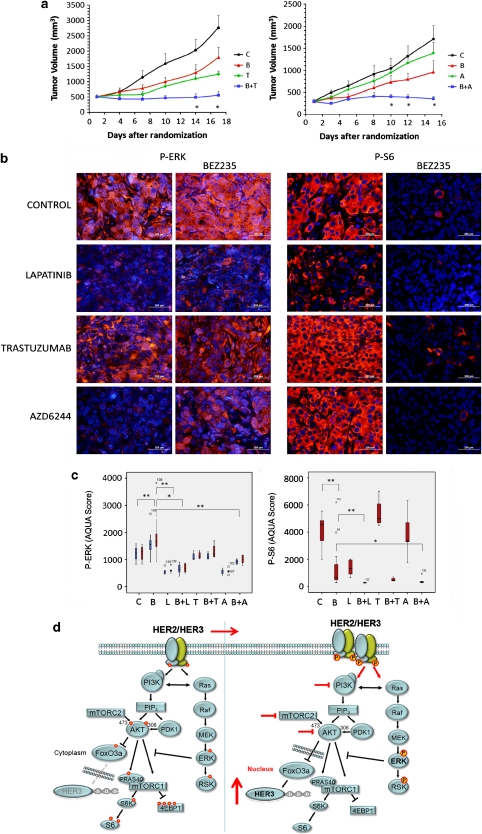Figure 6.
Combined inhibition of PI3K/mTOR and HER2 or PI3K/mTOR and MEK results in greater inhibition of tumor growth and prevents ERK transactivation in vivo. (a) Left panel: tumor growth of BT474-Tr-derived xenografts treated with placebo (c), BEZ235 (B, 20 mg/kg, QD), trastuzumab (T, 20 mg/kg, BIW) or the combination of both. Right panel: tumor growth of BT474-Tr xenografts treated with placebo (c), BEZ235 (B, 25 mg/kg, QD) as single agent or combined with AZD6244 (A, 8 mg/kg, QD). *P<0.05. Error bars indicate SE of at least 10 mice. (b) Immunofluorescence of BT474-Tr xenografts treated with placebo (c), BEZ235 (40 mg/kg, 4 × QD), lapatinib (120 mg/kg, 3 × QD), trastuzumab (20 mg/kg, days 1 and 3), AZD6244 (15 mg/kg, 4 × QD) or in combination as indicated. Red indicates primary antibodies; blue indicates DAPI staining. White bars, 200 μm. (c) Images were quantified with AQUA™. Red indicates nuclear stain; blue indicates cytoplasmic stain. *P<0.05; **P<0.01. (d) Cartoon outlining the PI3K/AKT/mTOR and RAS/RAF/MEK/ERK pathways. Inhibition of PI3K/AKT causes nuclear relocalization of the FoxO3a transcription factor and increase of HER3 mRNA and protein. The augmented HER3 is able to heterodimerize with HER2, therefore enhancing receptor phosphorylation and signaling to the PI3K and ERK pathways.

